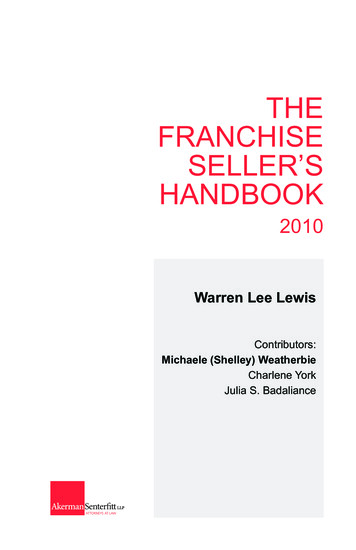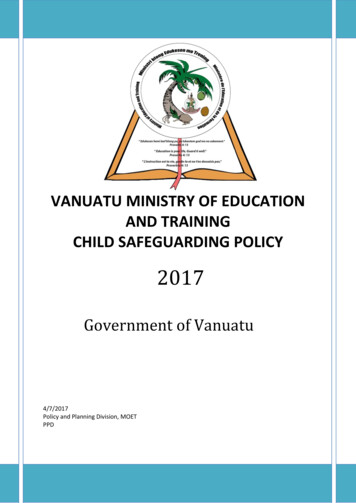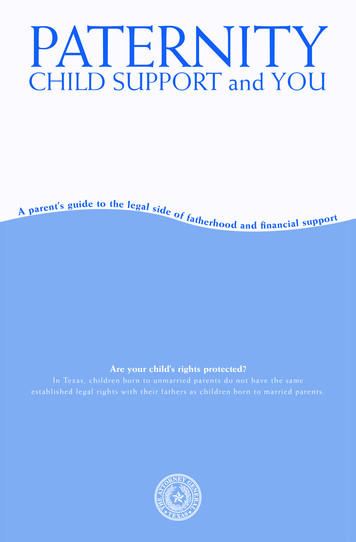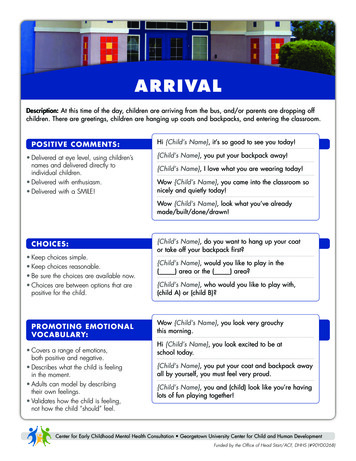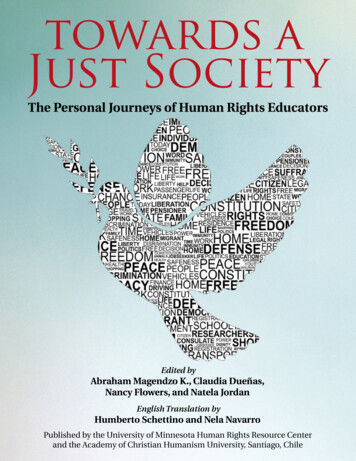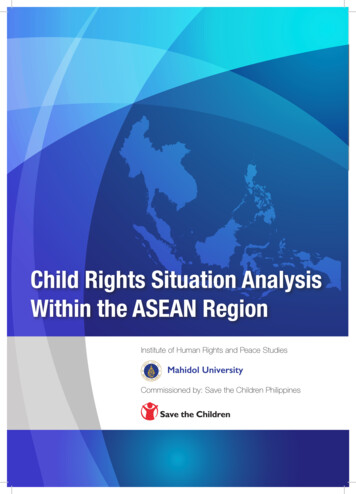
Transcription
Child Rights Situation AnalysisWithin the ASEAN RegionInstitute of Human Rights and Peace StudiesCommissioned by: Save the Children Philippines
ACKNOWLEDGEMENTSWe would like to express our sincere thanks to Save the Children Philippines, Save the Children AsiaRegional Office and Save the Children Sweden especially Hope Esquillo Tura, Manager for the RegionalChild Rights Governance Program, and her colleagues for their unreserved support and inputs throughoutthe process of conducting the study. Thanks to all participants of the focus groups in Brunei, Malaysiaand Singapore as well as to those who kindly spared time to our researchers for interviews. Specialthanks to all participants in the two regional consultations held in Bangkok which helped us to verifythe research findings and contributed to sharpening our recommendations. We would also like toextend our sincere appreciation to all colleagues of Save the Children in Cambodia, Indonesia, Lao PDR,Myanmar, the Philippines, Thailand, and Vietnam for sharing with us their reports and their inputs toimprove our country studies.The research and reports could not have been properly conducted and prepared without hard worksof all researchers. Their contributions are highly appreciated.This Child Rights Situation Analysis in the Association of South East Asian Nations (ASEAN) wascommissioned by Save the Children Philippines and funded by Save the Children Sweden and wethank them for such a support.The Regional Study TeamDisclaimerThis material is fully financed by Sida, the Swedish International Development Authority. Sida does notnecessarily share the views here expressed. Responsibility for the content is solely the author’s.Child Rights Situation Analysis within the ASEAN Regioni
STUDY TEAM MEMBERSRegional Study TeamSriprapha PetcharamesreeMark CapaldiVachararutai BoontinandContributors to the Regional SynthesisSriprapha PetcharamesreeMark CapaldiVachararutai BoontinandCountry ResearchersBrunei DarusalamCambodiaIndonesiaLao namRegional CoordinatoriiHarpreet Kahlon and Rangsima DeesawaseMark CapaldiRyan Jeremiah D. QuanVachararutai BoontinandAyesah Uy Abubakar and Maya DaniaAbhay LuthraKlarise Anne C EstorninosMichelle DcruzRangsima DeesawaseSriprapha PetcharamesreeSunsanee SutthisunsaneeChild Rights Situation Analysis within the ASEAN Region
FOREWARDThe realization of children’s rights is at the core Save the Children work. It is Who we are. It is What wedo. Our vision is a world in which every child attains their rights to survival, protection, developmentand participation. Save the Children is working to inspire breakthroughs in the way the world treatschildren, and to achieve immediate and lasting change in their lives.The Child Rights Situation Analysis (CRSA) has informed Save the Children’s strategic decision-makingsince the United Nations Convention on the Rights of the Child came into force in 1990. CRSA enablesus to understand the extent to which children’s rights are being fulfilled and the obstacles to theirrealization. CRSAs inform Save the Children’s program priorities and where we focus our resources andpartnerships to improve the lives of children in the 120 countries where we work.This Child Rights Situation Analysis within the Association of Southeast Asian Nations (ASEAN),which was carried out by the Institute of Human Rights and Peace Studies, Mahidol University, is thefirst of its kind in Asia. It provides a comprehensive overview and analysis of the situation of childrenin 10 ASEAN Member States. The report examines the gaps and violations of children’s rights and theunderlying causes holding back the achievement of rights within the ASEAN region. This analysis lookedinto the legal and policy frameworks at national and regional levels which impact both positively andnegatively on children. It examines how governments are progressing in their obligation to respect,protect and fulfill children’s rights.As a member of the international development community, Save the Children recognizes the importanceof working collaboratively with civil society and governments at local, national, regional and internationallevels to address children’s issues and fulfil children’s rights. The findings from this study will inform ourprogram priorities in the ASEAN region. We hope you will find this study relevant for the promotionand protection of children’s rights in the ASEAN region.Edward Olney Jr.Country DirectorSave the Children PhilippinesChild Rights Situation Analysis within the ASEAN Regioniii
TABLE OF CONTENTPage (s)AcknowledgementsiStudy Team MembersiiForewardiiiTable of ContentivList of TableviList of AcronymsviiExecutive SummaryixCHAPTER I:INTRODUCTION1 Background1 Study Methods2CONTEXTUALIZING ASEAN AND CHILDREN IN ASEAN4 ASEAN at a Glance4 ASEAN and its Peoples5 Children in ASEAN: The perspective before the advent of ACWC9CHAPTER II:CHAPTER III:ASEAN STANDARDS AND MECHANISMS FOR THE PROMOTION ANDPROTECTION OF THE RIGHTS OF THE CHILD11 Commitments and Implementation So Far: Reflections11 Existing Relevant Regional Documents and Mechanisms Pertaining to Children 14CHAPTER IV:ivRIGHTS-BASED ANALYSIS TO CHILD RIGHTS (four principles of the CRC)22 Non-Discrimination22 Best Interest of the Child23 Survival and Development24 Children’s Participation26Child Rights Situation Analysis within the ASEAN Region
CHAPTER V:LEGAL FRAMEWORK AND POLICIES ON CHILD RIGHTS IN ASEAN28 Ratification of CRC and its optional protocols28 National laws on child rights31 Definition of a child and minimum legal age33 National policies and plans on child rights37CHAPTER VI: REGIONAL STRATEGIC COMPONENTSCHAPTER VII:39 Stakeholders and accountability39 Risk Analysis50 Dynamism53CRITICAL ISSUES AND GAPS (‘CLUSTER APPROACH’)55 Civil rights and freedoms55 Basic education, health and welfare56 Special protection measures58 Family environment and alternative care61CHAPTER VIII: CONCLUSIONS, REGIONAL TRENDS AND RECOMMENDATIONS63 Regional Trends64 ASEAN Vision 2025 and the UN Sustainable Development Goals: Prospects?66 Recommendations69Child Rights Situation Analysis within the ASEAN Regionv
LIST OF TABLEPage (s)Table 1: ASEAN population6Table 2: ASEAN population age group.6Table 3: ASEAN population by age group in 20137Table 4: ASEAN population by age group8Table 5: Population by sex8Table 6: Status of Ratification of CRC and the two Optional Protocols29Table 7: Status of Ratifications of International Human Rights Instruments30Table 8: Status of Ratifications ILO Core Conventions31Table 9: Definition of a child and minimum age in legislations relevant to child rightsin ASEAN countries36Table 10: Expenditure on Health and Education in ASEAN Countriesvi42Child Rights Situation Analysis within the ASEAN Region
LIST OF ACRONYMSACFASEAN Children’s ForumACMWASEAN Committee on the Implementation of the ASEAN Declaration on the Promotionand Protection of the Rights of Migrant WorkersACWCASEAN Commission on the Promotion and Protection of the Rights of Women andChildrenAHRDASEAN Human Rights DeclarationAICHRASEAN Intergovernmental Commission on Human RightsAHRCAteneo Human Rights CenterAMMSWDASEAN Ministerial Meeting on Social Welfare and DevelopmentAMSASEAN Member StatesASEANAssociation of Southeast Asian NationsASCCASEAN Socio-Cultural CommunityBDCBarangay Development Council - PhilippinesCBCPCommune Councils and Community-Based Child Protection Networks – PhilippinesCBOsCommunity-Based OrganizationsCEDAWConvention on the Elimination of all Forms of Discrimination Against WomenCNCCNational Council for Children - CambodiaCPCCCommittee for the Protection and Care of Children – VietnamCPMSChild Protection Monitoring and Response System – ThailandCPNsChild Protection and Assistance Network – Lao PDRCRBPChildren’s Rights and Business PrinciplesCRCConvention on the Rights of the ChildCRGChild Rights GovernanceCRSAChildren’s Rights Situation AnalysisCSECNational Plan of Action against Commercial and Sexual Exploitation against Children –Lao PDRCSOsCivil Society OrganisationsCSRCorporate Social ResponsibilitiesCWCCouncil for the Welfare of Children - PhilippinesEVAWCEliminating Violence Against Women and ChildrenFGDFocus group discussionsGDPGross Domestic ProductHIV/AIDSHuman immunodeficiency virus infection / acquired immunodeficiency syndromeIAIInitiative for ASEAN IntegrationIBLIndonesia Business LinksICRMWInternational Convention on the Protection of the Rights of Migrant Workers and Membersof their FamiliesICTInformation and Communications TechnologyChild Rights Situation Analysis within the ASEAN Regionvii
IDPsInternally displaced personsIGCNGlobal Compact NetworkILOInternational Labour OrganisationIOInternational OrganisationsIOMInternational Organisation on MigrationKPPPAIMinistry of Women’s Empowerment and Child Protection - IndonesiaLCPCLocal Council for the Protection of the Child - PhilippinesLGBTLesbian, Gay, Bisexual and TransgenderLGBTIQLesbian, Gay, Bisexual, Transgender, Intersex and Questioning peopleMAPCMalaysian Association for the Protection of ChildrenMCRIMalaysian Children Resource InstituteMDGMillennium Development GoalsMKKMMalaysia Council of Child WelfareMLSWMinistry of Labour and Social Welfare – Lao PDRMSFMinistry of Social and Family Development – SingaporeMWFCDMinistry of Women Family and Community Development – MalaysiaNAPC-CBSNational Anti-Poverty Commission Children Basic Sector - PhilippinesNCMCNational Commission for Mother and Child – Lao PDRNCRCNational Committee on the Rights of the Child - MyanmarNHRCNational Human Rights CommissionNHRIsNational Human Rights InstitutionsNGOsNon-Governmental OrganizationsOECDOrganisation for Economic Co-operation and DevelopmentODAOfficial Development AssistanceOP-CRC-ACOptional Protocol to the Convention on the Rights of the Child on the involvement ofchildren in armed conflictOP-CRC-CPOptional Protocol to CRC on communication procedureOP-CRC-SCOptional Protocol to the Convention on the Rights of the Child on the sale of children,child prostitution and child pornographyPOsPeople OrganizationsSCISave the Children InternationalSDGsSustainable Development GoalsSLOMSenior Labour Officials MeetingSMEsSmall and Medium EnterprisesTORTerms of ReferenceUNUnited NationsUNICEFUnited Nations Children’s FundUNHCRUnited Nations High Commissioner for RefugeesVAPVientiane Action ProgrammeWHOWorld Health OrganisationviiiChild Rights Situation Analysis within the ASEAN Region
EXECUTIVE SUMMARYBackgroundIn the endeavor of promoting and protecting rights and well beings of the child, Save theChildren sees the importance of having a good understanding of the situation for children in thecountry context in order to inform its strategic decisions at the regional level. Save the Childrentherefore commissioned the Institute of Human Rights and Peace Studies, Mahidol University,to carry out a comprehensive Regional Children’s Rights Situation Analysis (CRSA) in ASEAN.The overall purpose of the Regional Children’s Rights Situation Analysis is to provide a comprehensiveoverview and analysis of the current situation of children in ASEAN member countries. The RegionalCRSA includes, among others, an examination of current rights violations and its underlyingcauses, including the accountabilities of duty bearers; analysis of relevant legal frameworks and ofthe perspectives of other stakeholders, including children, as well as, looking at the environmentof changes taking place and likely to take place over the next three to five plus years and howthese may affect children’s rights. The purpose is to enable Save the Children and its partner civilsociety organizations to make the appropriate strategic choices about what needs to be done toimprove children’s lives, in the context of ASEAN and ASEAN Member States (AMS), in particular.The study has employed mainly desk reviews and a detailed study including field researches in threecountries where Save the Children does not have presence (namely Brunei, Malaysia and Singapore).It also examines other sources of literatures and policy statements of ASEAN and AMS. The studyalso looks at emerging/new children’s rights issues or those that Save the Children in SoutheastAsia has not worked on in the past so as to balance program experience with new opportunitiesfor engagement that will have a positive impact on children’s lives. The Study Team also conductedstakeholders’ interviews and focus group discussions with children especially in the three countriesas stated earlier. Two regional consultations were organized with relevant Save the Children staffas well as representatives from civil society, government and academia in ASEAN Member States.There are some limitations that the Team faced in the process of this study. The quantitativedata is scarce in the region and this has implications on analyzing the disaggregation ofchildren’s rights mapping disaggregation of data by gender, ethnicity, disability and age.The Team, to a certain extent was able to do a stakeholder analysis by looking at roles andresponsibilities, capacity gap analysis, and trends analysis; however, there is room for further research.Child Rights Situation Analysis within the ASEAN Regionix
Rights ConcernsUsing the generic state human rights obligations of “respect-protect-fulfill” as a framework for synthesis,the human rights concerns for children in ASEAN could be summarized as follows.A snapshot of rights concerns for children within the ASEAN regionIt has been demonstrated in the studies that most, if not all countries in ASEAN, have made significantprogress in promoting and protecting child rights. Laws and policies were put in place with institutionsestablished in order to implement their commitments. Nevertheless, gaps and risks remain to be filledand there is a need for every country to prepare themselves for future challenges lying ahead.xChild Rights Situation Analysis within the ASEAN Region
At the regional level, ASEAN has made a clear commitment to ensure rights and well-being of childrenin the region. Not only were legal and political documents adopted but institutions such as the ASEANCommission on the Promotion and Protection of the Rights of Women and Children (ACWC) and theASEAN Inter-governmental Commission of Human Rights (AICHR) were also established to follow upthe implementation, although not without constraints and challenges.Based on the findings of this study, the following are trends that Save the Children may consider payingattention to in the next one to 10 years.Regional TrendsThe analysis of 10 country child rights studies reveals some common trends among ASEAN MemberStates regarding child rights and factors which may impact children, namely:1. Difficulties with the move towards democracy in AMS. There has been political recession ina number of countries in ASEAN such as Thailand, Malaysia and Indonesia while status quo ismaintained in a few others including Vietnam, Lao PDR, and Brunei. In these countries changeswould be minimal. Positive political changes are seen in Myanmar after the November 2015elections whereby the results were accepted by the military and current leaders. Across theregion, the political situation is a barometer which could measure the political space that CSOscould have in each society. Not only does it determine people’s participation but it also affectschild participation in decision making. At the regional level, the ASEAN post 2015 vision seemsto be more open to CSO engagement.2. Continued bias in development towards industrialization. ASEAN seems stuck in the “middleincome trap” as most of the countries try to become middle income nations as part of narrowingthe development gap not only within a country but also within the region. The middle incomeendeavor has put many countries at risk as it depends highly on the industrialization and servicesector such as tourism in order to boost their economies. For example, harmful practices,including child labor in the service industry can have a rather negative impact on children.In most countries, government investments are prioritized for economic development ratherthan social development. Although basic social services such as health care and education areavailable, the problem is accessibility and affordability of quality social services.3. Environment and climate change. Environmental-related problems including that of climatechange are affecting people including children in the region more severely. The rising trend ofmore frequent occurrence of natural disasters including floods and droughts is resulting in moredamage to the livelihood of people especially the poor and marginalized, and those living inthe rural areas. The recent haze crisis in the region stemming from forest fire/ burning has ledto temporary closure of schools in Indonesia, Malaysia and Singapore and many children haveended up missing out on their education. Yet, effective disaster risk reduction and emergenciesresponse programs and interventions, especially those which are child-sensitive, are not in placein many countries. With the problem of climate change affecting people and children acrosscountries and regions, commitments are needed at the national and regional level to tacklethe issues from a more holistic approach.Child Rights Situation Analysis within the ASEAN Regionxi
4. Corruption remains a critical issue. Unfortunately, corruption still plagues the region as mostpublic institutions in many countries in ASEAN continue to lack transparency and accountability.Lack of anti-corruption laws and restricted civil society engagement in public policy as well as inbudgeting planning and monitoring also contribute to the sustained practice of corruption inmany ASEAN countries. According to Transparency International, “almost 50 per cent of peoplein ASEAN countries believe corruption has increased, while only a third say their government’sefforts to fight corruption have been effective” With many countries in the region still needingto deliver quality social services such as healthcare and education for their people, corruptionwill continue to pose great risk to the countries’ development and well-being of the people.Reversing this trend should constitute a key priority for countries in the region.5. More critical roles for the private sector. As a main driver of economic growth in many ASEANcountries, the private sector plays increasing roles both as potential contributors to and violatorsof people’s and children’s rights. With the anticipated growing cross- border trade and investmentthat accompany regional economic integration, there is a greater need for the private sector(both domestic and international origins) to be more accountable to the people and communitiesaffected by their operations. While there are emerging good practices regarding the privatesector’s engagements in the promotion and protection of children rights, especially throughthe development of Child Rights Business Principles, the trend in this direction remains limited.In this regard, the potential roles and engagement with the private sector as a supporter ofchildren’s and people’s rights need to be further explored and promoted.6. Lesbian, Gay, Bisexual and Transgender (LGBT). Recognition of the rights of LGBT is growingwithin some countries of the region. Vietnam has just become the first country in ASEAN toadopt a law on same sex marriage and Thailand has a draft law that is being prepared forparliament that seeks to offer LGBT the same rights as heterosexuals. Still concrete changes arelimited. LGBT rights are limited in the ASEAN region compared to many other regions of theworld. ASEAN countries currently do not have anti-discrimination laws to guarantee equalityof all citizens regardless of their sexual orientation and gender identity. Social stigma anddiscrimination across ASEAN of LGBT people limit job and education opportunities, as wellas access to healthcare. Violence, bullying and other forms of abuse and harassment againstLGBT are also found in schools. Homosexuality remains criminalized in places which abide bystrict Sharia law, and the Roman Catholic Church remains in opposition to any such unions.Some countries still adhere to out-dated colonial-era law that bans same-sex intercourse. Thissituation seems set to remain.7. Migration. Migration has been always problematic in the region. There is no unified regionalpolicy on the issues regarding migrant workers, refugees, stateless persons and unaccompaniedand separated children. The establishment and consolidation of the ASEAN Economic Communitywill continue to increase the migration of people facing economic, political difficulties as wellas conflicts and persecution in their own countries. Challenges created by migration concernchild welfare and protection. In addition, most of migrants leave their children behind whenmigrating internally or transnationally. It is also estimated that 5-10 % of migrants are childrenand many of them do not have birth registration.xiiChild Rights Situation Analysis within the ASEAN Region
8. Ongoing internal conflicts. A number of ASEAN member states seem to be experiencingprolonged internal conflicts which have negatively affected socioeconomic and democraticdevelopment of the countries. People, including children, living in the conflict areas are directlyimpacted and their basic rights to bodily integrity, safety, livelihood, healthcare and education,among others, are violated on a daily basis. The involvement of children in armed conflict, aschild soldiers in some countries, also pose serious concerns. The number of children who havebecome refugees or are displaced and separated from their families as a result of a conflictsituation is also increasing. Given that effective protection mechanisms for children affectedby armed conflict are either weak or non-existent in several ASEAN Member States, greaterefforts are needed at the regional level to address the issues of protection of children in thisparticular context.9. Persistence of some traditional values that undermine human rights and children’s rights.Despite socioeconomic changes that have accompanied development in countries acrossASEAN (including the impact of globalization that has brought about new ideas and practices)the impact of globalization that has brought about new ideas and practices certain valuesremain strong in ASEAN societies. Among these are values and practices relating to genderroles and relations that favor male superiority, and the power relationship between adultsand youngsters that helps to condone the practice of corporal punishment in children. Thetrend and manifestations of continuing and growing violence against women and children inASEAN societies are a reflection of societal acceptance of such practices. Reversing the trendwill require not only a re-socialization of the current and the new generation of ASEAN citizenstoward the culture of respect for rights and equality, but also to put in place effective institutionalmechanisms to enable rights-respecting culture to take roots.10. Maintaining the status quo of regional human rights mechanisms. ASEAN has developed theregional human rights regime with political documents and mechanisms such as the AICHR andACWC. However, the two existing human rights bodies are still struggling to perform effectivelydue to a lack of independence, personal resources, proper secretariat, capacity and expertise. Thestruggle, unfortunately, will continue because of the ASEAN working principles of consultationand consensus as well as respect for state sovereignty and non interference in internal affairsof the AMS. While a few member states are trying their best to keep the current status andsituation of the two bodies, which is not conducive to better performance, engagement withdifferent individual representatives is possible and could be useful.ASEAN Vision 2025 and the UN Sustainable Development Goals:Prospects?The key question here is whether the ASEAN Post-2015 vision offers any prospects? The ASEANleaders, during its 27 Summit held in Kuala Lumpur on the 18-22 November 2015 adopted a numberof documents. One of the most important for ASEAN to move forward together is the ASEAN 2025:Forging Ahead Together. The document contains an ASEAN Community Vision 2025 and threeCommunity Blueprints (namely ASEAN Political-Security Community Blueprint 2025, ASEAN EconomicCommunity Blueprint 2025, and the ASEAN Socio-Cultural Community Blueprint 2025). The KualaLumpur Declaration on ASEAN 2025: Forging Ahead Together “welcomes the formal establishment ofthe ASEAN Community 2015” and “adopts the ASEAN Community Vision 2025”. It charts the path forChild Rights Situation Analysis within the ASEAN Regionxiii
ASEAN Community building over the next ten years. ASEAN is working towards a Community that is“politically cohesive, economically integrated, and socially responsible socially responsible”. Whateverthese grand statements mean, the implementation of many strategies and action points will have director indirect impact on children and child rights.The ASEAN vision 2025 emphasizes a rules-based, people oriented, people centered ASEAN Community,where “peoples enjoy human rights and fundamental freedoms, higher quality of life and the benefitsof community building”. It was said that one of the focuses for the ASEAN Community over the next tenyears would be guided by, but not limited to, broad goals that will further consolidate and strengthenthe regional grouping. These are meant to include, among others, “greater emphasis on the peoplesof ASEAN and their well-being” and “ensure fundamental freedoms, human rights and better livesfor all ASEAN peoples”. It commits to undertake to realize among others, “an inclusive and responsivecommunity that ensures our peoples enjoy human rights and fundamental freedoms as well as thrivein a just, democratic, harmonious and gender-sensitive environment in accordance with the principlesof democracy, good governance and rule of law”. For a region where democracy seems to be in deficitin a majority of the member states and where human rights violations are rampant, the post-2015vision is ambitious. Nevertheless, the fact that human rights and fundamental freedoms have becomecross-cutting through all three communities could be a step towards a more human rights friendlycommunity, including for children.For the first time, the endeavor to build an ASEAN people-oriented and people-centered society isreflected through all communities including the ASEAN Economic Community. Although compromised,space is now open for peoples of ASEAN, including children, to advocate/demand for more participationin any decisions which may affect them.The post 2015 ASEAN vision touches upon various issues identified as risks and challenges for childrenand the promotion and protection of child rights as follows:1. Political-security blueprint. Among the four characteristics to be pursued include “a rules based,people-oriented, people-centered community in which our peoples enjoy human rights,fundamental freedoms and social justice, embrace the values of tolerance and moderation ”.Under this, a number of elements were identified as essential for community consolidationincluding: promotion of the principles of democracy; instill the culture of good governance;the culture of integrity and anti-corruption; promotion and protection of human rights,fundamental freedoms and social justice; as well as increase the engagement and participationof entities associated with ASEAN and relevant stakeholders. Out of 15 action lines under “thepromotion and protection of human rights, fundamental freedoms and social justice”, morethan half aim at supporting the AICHR to properly discharge its mandates and functions as wellas implementation of the ASEAN Human Rights Declaration (AHRD). The “mainstreaming ofhuman rights across all three pillars of ASEAN Community” was clearly stated in the blueprint.Engagement and interactions with existing human rights mechanisms and CSOs concernedwith human rights were mentioned in a few action points.Children were also mentioned in the political and security blueprint. Action line fourteen“encourage coordination and consultation among relevant ASEAN organs and bodies with aview of enhancing the implementation of the AHRD, the Ha Noi Declaration on the Enhancementof Welfare and Development of ASEAN Women and Children ”. The Ha Noi Declaration, whichwas adopted in 2010, prescribes very clear measures regarding the promotion and protectionof child rights (as well as women’s rights) including to “achieve the goals for children in thexivChild Rights Situation Analysis within the ASEAN Region
ASEAN region as regards the child’s rights to survival, protection, development and participationin a comprehensive and systematic way” and “promote and encourage child participation inthe ASEAN Community building through the establishment of the ASEAN Children’s Forumand other relevant programs or activities”. The next ASEAN Children’s Forum will be hosted byVietnam in 2016. In addition, the blueprint also prescribes the “early ratification of the ASEANConvention against Trafficking in Persons, Especially Women and Children and its effectiveimplementation, as well as carry out the ASEAN Plan of Action against Trafficking in Persons,Especially Women and Children. The said Convention was adopted by the ASEAN leaders onNovember 22, 2015.2. Economic blueprint. This is a continuity of economic integration which will be consolidatedin the next 10 years. It still emphasizes the “free flow” of trade in goods, services, investmentas well as skilled labor. It focuses on a competitive ASEAN and connectivity through physicalinfrastructures and information technology. The blue
CPCC Committee for the Protection and Care of Children - Vietnam CPMS Child Protection Monitoring and Response System - Thailand CPNs Child Protection and Assistance Network - Lao PDR CRBP Children's Rights and Business Principles CRC Convention on the Rights of the Child CRG Child Rights Governance
